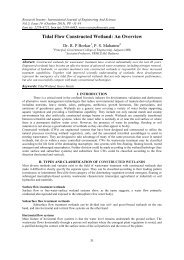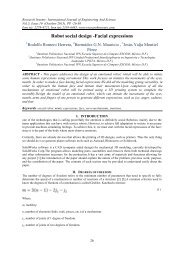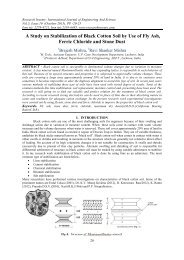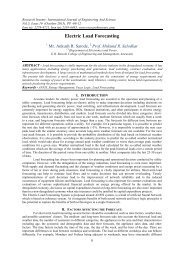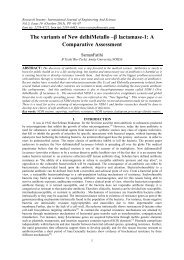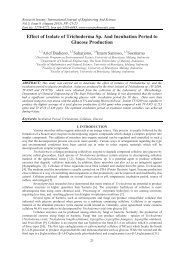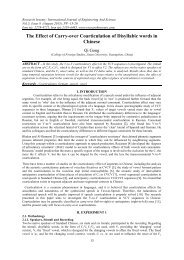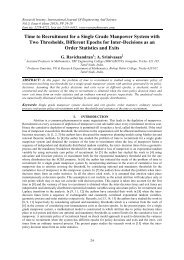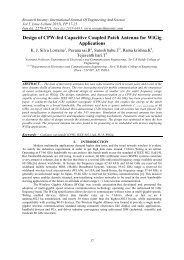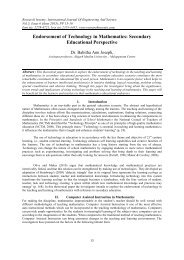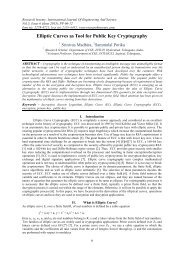Experimental Investigation of a Helical Coil Heat Exchanger
- No tags were found...
Create successful ePaper yourself
Turn your PDF publications into a flip-book with our unique Google optimized e-Paper software.
<strong>Experimental</strong> <strong>Investigation</strong> <strong>of</strong>…<br />
Table II<br />
<strong>Experimental</strong> observations <strong>of</strong> overall heat transfer coefficients Vs inlet temperature <strong>of</strong> hot water for helical coil<br />
and straight tube heat exchangers<br />
IV. CONCLUSIONS<br />
<strong>Experimental</strong> analysis for a helical coil heat exchanger was carried out and the results are compared<br />
with the straight coil under similar geometrical and operating conditions. The results <strong>of</strong> the helical coil heat<br />
exchanger are compared with the straight tube heat exchanger in parallel flow by varying parameters like<br />
temperature, flow rate <strong>of</strong> cold water and hot water. Based on the results obtained by conducting the experiments<br />
on helical (parallel flow) and straight (parallel flow) tube, the following conclusions are drawn.<br />
The main conclusions are listed as follows:<br />
1) The helical tube allows the fluid to be in contact for greater period <strong>of</strong> time so that there is an enhanced<br />
heat transfer compared to that <strong>of</strong> straight tube.<br />
2) Comparative study is carried out between helical coil heat exchanger and straight tube heat exchanger.<br />
The effectiveness and overall heat transfer coefficient <strong>of</strong> heat exchanger greatly affected by the hot<br />
water mass flow rate and cold water flow rate. When cold water mass flow rate is constant and hot<br />
water mass flow rate is increased both the effectiveness as well as the overall heat transfer coefficient<br />
increases.<br />
3) Results indicated that helical coil heat exchanger showed increase in the heat transfer rate,<br />
effectiveness and overall heat transfer coefficient over the straight tube heat exchanger on all mass flow<br />
rates and operating conditions.<br />
4) The centrifugal force due to the curvature <strong>of</strong> the tube results in the secondary flow development which<br />
enhances the heat transfer rate.<br />
5) Comparative study shows that helical coil heat exchanger is having better performance that straight<br />
tube heat exchanger.<br />
ACKNOWLEDGEMENT<br />
This study was supported by the UG section, Department <strong>of</strong> Mechanical Engineering, Jyothi Engineering<br />
College, Thrissur-679 531, Kerala, India.<br />
REFERENCES<br />
[1] Swapnil Ahire, Purushottam Shelke, Bhalchandra Shinde, Nilesh Totala, “Fabrication and Analysis <strong>of</strong> Counter Flow <strong>Helical</strong> <strong>Coil</strong><br />
<strong>Heat</strong> <strong>Exchanger</strong>”, International Journal <strong>of</strong> Engineering Trends and Technology (IJETT) – Volume 15 Number 5, (September<br />
2014).<br />
[2] B. Chinna Ankanna, B. Sidda Reddy, “Performance Analysis <strong>of</strong> Fabricated <strong>Helical</strong> <strong>Coil</strong> <strong>Heat</strong> <strong>Exchanger</strong>”, International Journal<br />
<strong>of</strong> Engineering Research, Volume No.3, Issue No: Special 1, pp: 33-39 (March 2014).<br />
[3] Shiva Kumar, K.Vasudev Karanth, “Numerical Analysis <strong>of</strong> a <strong>Helical</strong> <strong>Coil</strong>ed <strong>Heat</strong> <strong>Exchanger</strong> using CFD”,International Journal <strong>of</strong><br />
Thermal Technologies, Vol.3, No.4, (December 2013).<br />
4



